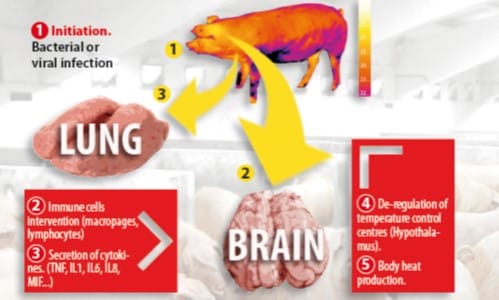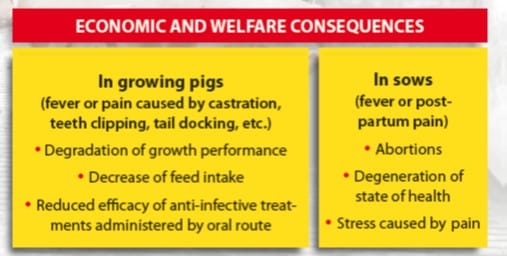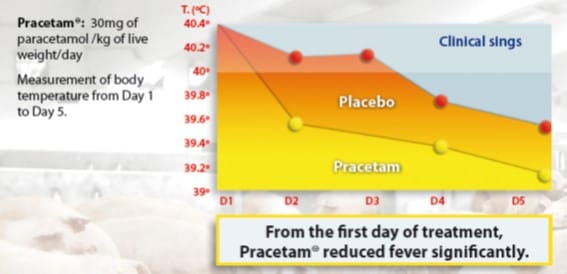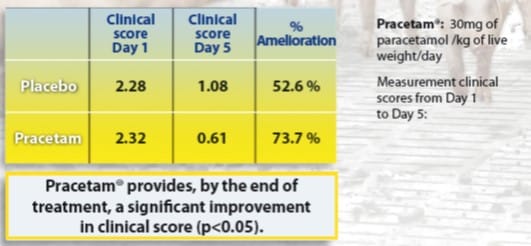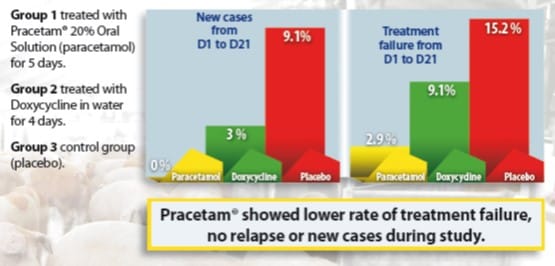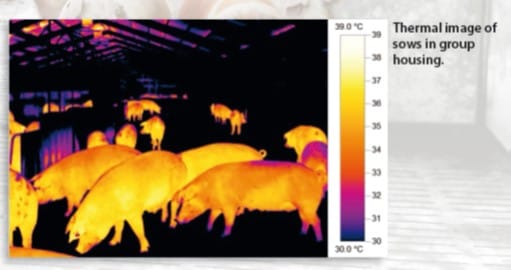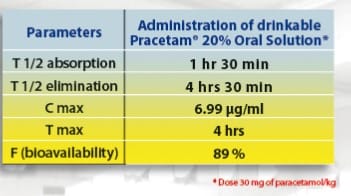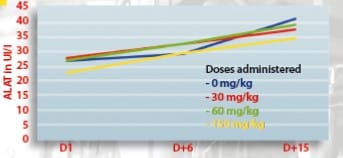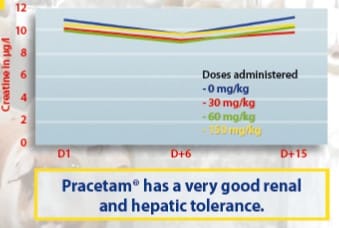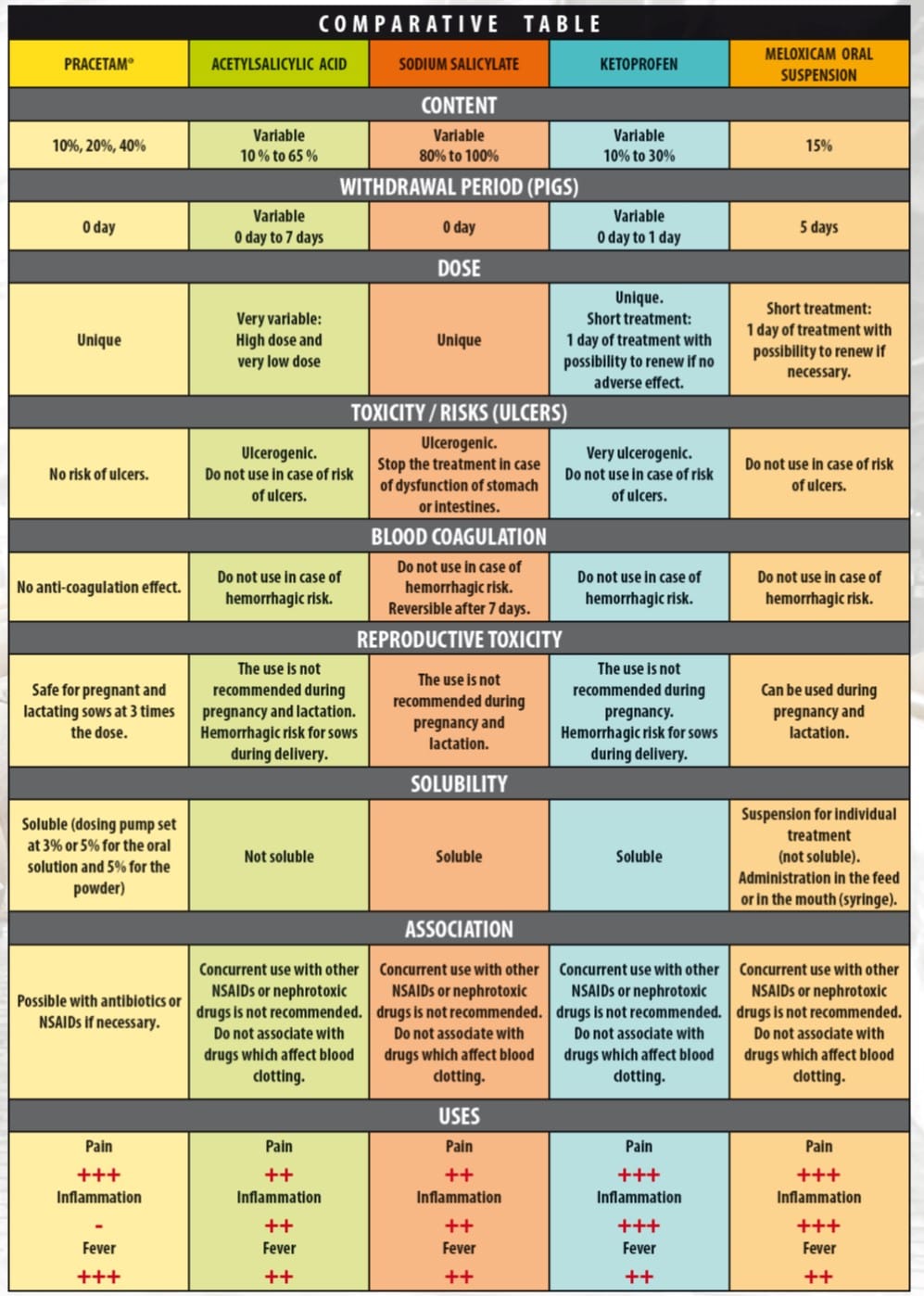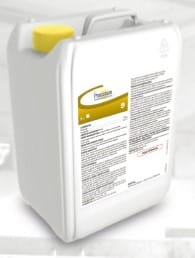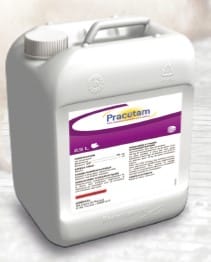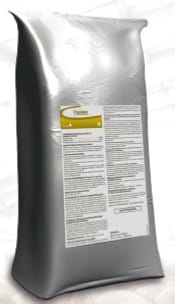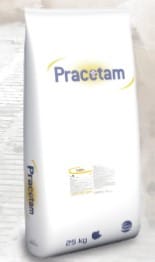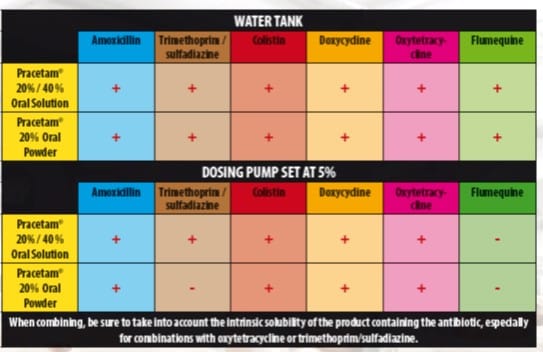Fever, mechanism and consequences
Fever is a means of defense for an organism, which follows an attack of viral or bacterial origin.
(1) Against this attack, the immune system is activated (2) and secretion of cytokines is obeserved, notably IL1. (3) Centrally, this secretion of cytokines leads to the activation of enzymes, the cyclooxygenases (COX). (4) These COX enzymes, by releasing prostaglandin E2 (PGE2), act on the temperature regulating mechanism of the hypothalamus centre and cause fever (5).
Although beneficial, fever should be controlled. Too high a fever can lead to associated clinical symptoms and can also diminish the efficacy of immune defenses.
Paracetamol mode of action
Paracetamol mechanism of action involves a number of central mechanisms and a combination of pathways (1). The antipyretic effect produced by paracetamol is due to reduction of the specific oxidase form of the COX enzymes, preventing it from forming proinflammatory chemicals (Harvison et al., 1986) which induce fever. (2) On the other hand, several pathways are involved in analgesic effect of paracetamol. Mechanisms which are involved are mainly endogenous cannabinoid system, serotonergic pathway and inhibition of proinflammatory compounds via effect on prostaglandin synthesis. In addition, its selective activity on peripheral cyclooxygenases type 2 (COX 2) ensures the absence of gastrointestinal toxicity and effects on blood coagulation because COX 1 in general has protective effect on many tissues including gastric tissue so its presence is important in standard healthy conditions (3).
A preliminary supporting study on the efficacy of PRACETAM 10% Premix has demonstrated the tight correlation between clinical scores and body temperature (p<0.001)1.
Fever can have harmful consequences on the general condition: depression, reduction of feed consumption, even anorexia; risk of secondary bacterial infection.
PRACETAM has a powerful analgesic effect reducing the stress caused by pain in animals and improving their welfare.
1. POMMIER P - CTPA 1996 - Etude cliniaue de Pracetam Prémélamge dans le traitement de la fièvre chez le porc - Dossier d'Autorisation de Mise sur le Marché.
PRACETAM: Proven efficient to fight fever and to improve the genral condition of pigs
Efficacy of PRACETAM has been tested during a multicentre, blinded, comparative study carried out in 4 European pig farms (In France, Italy and Germany) with PRACETAM 20% Oral Solution2.
In each trial, PRACETAM was administered during a swine flu outbreak marked by fever (rectal temperature over 40°C) associated with clinical symptoms (depression, polypnea and/or dyspnea, anorexia)> Each time, PRACETAM was administered alone, at a dose of 30mg per kg of live weight during 5 days, without any associated antibiotic.
- By reducing fever, PRACETAM contributes also to a significant amelioration the state of health of the animal: this has been confirmed by measuring the clinical scores.
2. POMMIER P., KEITA A. - CTPA 1997 - Rapport d'efficacité du paracétamol (Pracetam) administré dans l'eau de boisson contre l'hyperthermie chez le porc - Dossier d'Autorisation de Mise sur le Marché.
Rational use of antibiotics with PRACETAM
PRACETAM helps reduce antibiotic use. A comparison study of the use of paracetamol, doxycycline or a placebo in a case of respiratory disease outbreak showed that PRACETAM helps treat fever and symptoms caused by viral infections (influenza, PRRSv), thus allowing rational use of antibiotics and reducing their consumption3.
A field trial (performed by good clinical practice study) was held on a conventional farm with a case of respiratory outbreak caused by influenza (ELISA tested) in order to compare the efficacy of two different treatments:
3. N. Capdevielle et al. 'PRACETAM and symptomatic medecine: a new approach of first line treatment' Proceedings of the 6th European Symposium of Porcine Health Management 2014.
PRACETAM: very rapid absorption
A pharmacokinetic study carried out with PRACETAM 20% Oral Solution has shown a very rapid absorption of paracetamol during its administration to pigs by the oral route in their drinking water. Thus, it is possible to obtain a nearly maximum concentration peak (Cmax) for better efficacy4.
Pharmacokinectic parameters determined in the pig after the adninistration of : PRACETAM 20% Oral Solution continuously administered in drinking water (30 mg of paracetamol/kg live weight/day).
Paracetamol's plasma concentrations (μg/ml) obtained in the pig after administration of: PRACETAM 20% Oral Solution in drinking water (30 mg/kg live weight/day).
Hepatic and renal tolerance
A tolerance study has been carried out on 24 animals of 20 kg, with a follow-up of the animals 8 days before the beginning of the trial and 15 days after. PRACETAM 20% Oral Solution was administered during 5 days using 1, 2 or 5 times the therapeutic dose5.
4. Etude interne - 2007 - Etude de dissolutin de PRACETAM 2096 poudre orale dans l'eau de boisson - Dossier d'Autorisation de Mise sur le Marché.
5. Rapport interne - 1996 - Etude de tolérance après administration aux espèces cibles (porcs) du PRACETAM 20% Solution buvable - Dossier d'Autorisation de Mise sur le Marché.
The criteria observed were:
- Symptoms of intolerance (vomiting, diarrhoea)
- Rectal temperature
- Weight gain
- Blood indicators of renal function (urea, creatine) and of hepatic function (bilirubin, alkaline phosphatase, ALAT, ASAT)
- Effect on hepatic parameters
Follow-up of alanine aminotransferase (ALAT) levels from Day 1 to Day 5
- Effect on renal parameters
Follow-up of creatine levels from Day 1 to Day 5
- Effect on weight gain
Weight gain of the animals from Day 1 to Day 5
Gastric tolerance
- No effect on gastric emptying
Some tests have been done on the effects of paracetamol administered by oral route on stomach emptying in the pig. Images are transferred on a treatment console. This console is using a program calculating the time of half-emptying (t1/2)6.
The results are convincing:
- The evacuation of test meals occurs without a latency phase
- No significant difference was noted concerning the half-emptying time
At the tested doses, PRACETAM does not modify the speed of evacuation of a semi-solid meal in pigs.
- No ulcerative effect on the stomach mucosa
A preliminary test in an experimental station using the measure of transmural potential demonstrates that paracetamol is not agressive toward the gastric mucosa.
Paracetamol is well tolerated at the gastric level: the measure of gastric emptying time as well as the non-ulcerative effect on the stomach mucosa has been confirmed.
- PRACETAM: the withdrawal period as an asset
Because of its weak toxicity, paracetamol has been listed in Annex II of the LMR regulation (the list of substances for which it does not appear necessary, for the protection of public health, to set a maximum residue limit).
In addition, as a result of its rapid absorption and elimination, there is no risk of accumulation of paracetamol.
Using PRACETAM 20% Oral Powder or PRACETAM 20% Oral Solution does not lead to any withdrawal period (0 day) before meat and offal production.
6. MALBERT G. - 2000 - Effet du paracétamol sur l'évacuation gastriaue et sur l'activité myoélectriaue chez les porcs. - Institut National de Recherche Agronomique.
Main indications
- Influenza-like syndrome / Respiratory disease
Sows: PRACETAM can be used throughout pregnancy and lactation.
Fattening pigs: PRACETAM can be used from weaning to slaughter for influenza-like syndrome, respiratory disease, PRRS outbreak or non-specific fever.
- Post vaccinal reactions
Sows: PRACETAM can be used at vaccination time, either just before or just after vaccination. Safety has been demonstrated in pregnant and lactating sows.
- Peripartum management
PRACETAM can be used around the farrowing period. Safety has been demonstrated in pregnant and lactating sows.
- Pain liked to castration
PRACETAM has been used in the field of a castration study. Security has been demonstrated in piglets.
- Post-weaning multisystemic wasting syndrome (PMWS)
PRACETAM can be used to reduce the clinical expression of PCV-2 (wasting piglets).
- Weaning period (stress management)
PRACETAM can be used during the weaning period (fever/stress).
Complete range
PRACETAM 20% Oral Solution- PRACETAM 20% Oral Solution for use in drinking water for pigs.
- Available packaging: 1L and 5L bottles.
- Highly soluble at ambient temperature in every kind of water qualities.
- Stability in solution guaranteed for 24 hours for optimal efficiency.
- The use of paracetamol in high concentrations with cold water can lead to the formation of crystals. Ceva recommends using PRACETAM Solution in dosing pumps set to 5% (3% minimum). The maximum solubility of PRACETAM Solution in cold water is 0.5 liters per 10 liters of water.
PRACETAM 40% Oral Solution
- PRACETAM 40% Oral Solution for use in drinking water for pigs.
- Available packaging: 0.5L, 1L, 2.5L, and 5L bottles.
- Recommended preparation at ambient temperature (20°-25°C). At temperature over 25°C do not reach concentration over 40ml/l.
- Stability in solution guarantee for 24 hours for optimal efficiency.
- Ceva recommends using PRACETAM 40% Oral Solution in dosing pumps set between 3% and 5%. Do not set below 2%.
PRACETAM 20% Oral Powder
- PRACETAM 20% Oral Powder for use in piglets.
- Available packaging: 10 kg bag.
- PRACETAM 20% Powder is completely dissolved in 5-10 minutes depending on water hardness and temperature conditions.
- The stability of PRACETAM 20% Oral Powder is excellent even 24 hours after being diluted in every kind of water qualities.
- The use of paracetamol in high concentrations with cold water can lead to the formation of crystals. Ceva recommends using PRACETAM Powder in dosing pumps set to at least 5%. The maximum solubility of PRACETAM Powder in cold water is 0.5 kg per 10 liters of water.
PRACETAM 10% Premix
- PRACETAM 10% Premix for medicated feeding stuff for pigs.
- Available packaging: 25 kg bag.
- Losses due to granulation are not significant: PRACETAM is stable in granular form.
- The medicated feed containing PRACETAM 10% Premix can be kept safely for 5 months.
- In terms of stability over time of a medicated feed containing PRACETAM 10% Premix combined with antibiotics, no significant degradation was observed in either the paracetamol or the antibiotics.
Compatibility with antibiotics for PRACETAM 20% / 40% Oral Solution and PRACETAM 20% Oral Powder in drinking water
PRACETAM:
- Better action against fever.
- Better general condition of animals.
- Better and rational use of antibiotics.
- Better absorption and tolerance.
- Better withdrawal period: 0 days.
- Better solubility and stability.
- Better tools for the best in business!

 Corporate Website
Corporate Website
 Africa
Africa
 Argentina
Argentina
 Asia
Asia
 Australia
Australia
 Belgium
Belgium
 Brazil
Brazil
 Bulgaria
Bulgaria
 Canada (EN)
Canada (EN)
 Chile
Chile
 China
China
 Colombia
Colombia
 Denmark
Denmark
 Egypt
Egypt
 France
France
 Germany
Germany
 Greece
Greece
 Hungary
Hungary
 Indonesia
Indonesia
 Italia
Italia
 India
India
 Japan
Japan
 Korea
Korea
 Malaysia
Malaysia
 Mexico
Mexico
 Middle East
Middle East
 Netherlands
Netherlands
 Peru
Peru
 Philippines
Philippines
 Poland
Poland
 Portugal
Portugal
 Romania
Romania
 Russia
Russia
 South Africa
South Africa
 Spain
Spain
 Sweden
Sweden
 Thailand
Thailand
 Tunisia
Tunisia
 Turkey
Turkey
 Ukraine
Ukraine
 United Kingdom
United Kingdom
 USA
USA
 Vietnam
Vietnam

